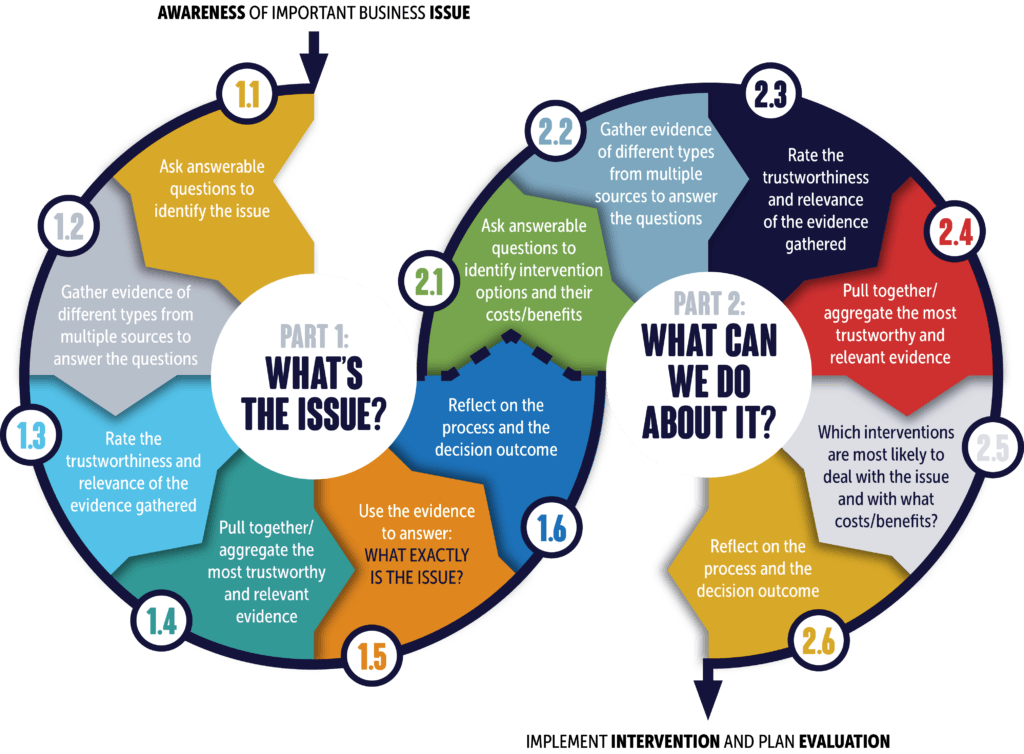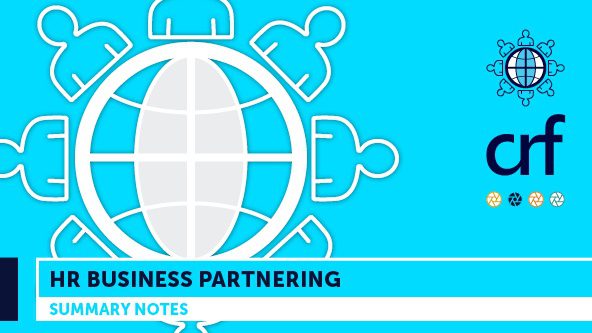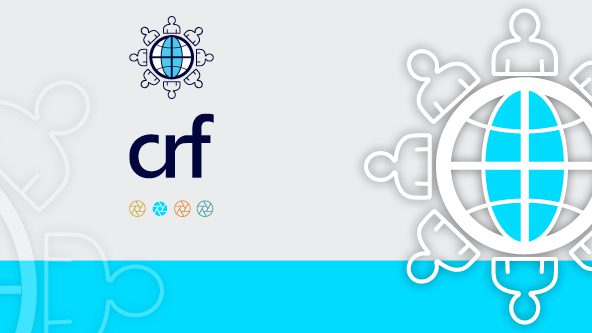Business Partnering
Summary Notes: Evidence-Based HR for HRBPs
According to CRF’s 2023 research, Reimagining HR Business Partnering, it is more important than ever that HR Business Partners (HRBPs) can effectively use data and evidence to build credibility, influence senior leaders and drive change. Building on this research, CRF hosted an online discussion for senior members of the HR Business Partner (HRBP) Community – “Evidence-Based HR for HRBPs”. During the session, CRF Associate Research Director Professor Rob Briner outlined how HRBPs can better use evidence to understand business issues, drive effective decision making and increase HR’s value. These notes summarise Prof. Rob Briner’s presentation as well as the following practitioner discussion.
Evidence-Based HR: Definitions and Overview
- There is now a widespread acceptance that the HR profession can increase its effectiveness through better using data and evidence. Whilst many HR functions have focused on increasing their use of data, the systematic use of evidence more broadly is still lacking.
- The overall purpose of Evidence-Based HR (EBHR) is to:
- Better understand the most important issues faced by clients and customers, and;
- Choose interventions that are most likely to resolve those issues.
- The key principles of evidence-based practice are:
- Incorporate multiple sources
- Adopt a structured and explicit approach
- Focus on the most trustworthy and relevant evidence.
Evidence-Based Decision-Making and HR Model
The CRF Evidence-Based HR process provides a structured approach to identifying the most important business problems or opportunities, and then making better informed decisions about the appropriate interventions. The key steps of this process are outlined below (please refer to CRF’s EBHR Toolkit for further detail).

First, ask ‘what is the issue’?
- Identify a business issue that has a direct and significant impact on the organisation. Example issues could relate to performance, finance, size, growth or survival.
- Ask answerable questions to better understand the issue.
- Gather evidence from multiple sources, questioning how reliable and trustworthy the data is. The four main sources of evidence are:
- Scientific and other external evidence
- Stakeholders’ perspectives and ethical concerns
- Evidence from inside the organisation
- Professional expertise.
Then, ask ‘what can we do about it?’
Once you have pulled together the most trustworthy and relevant evidence, the next step is to reflect on the process and the decision outcome. This includes identifying potential interventions, understanding the goals, benefits and costs of each, and evaluating their effectiveness.
EBHR: Practical Tips
- Not all decisions or interventions require the EBHR process. The below questions can help you to decide whether EBHR might be appropriate:
- Is the business issue crucial or really important?
- Is the intervention costly in terms of time, people or money?
- If the intervention goes wrong, could there be serious legal or other consequences?
- Will you be asked in the future to show an audit trail of how decisions were made?
- EBHR should be designed into project planning, rather than being an extra, standalone task.
- Whilst the EBHR process may seem complex or time-consuming, it is worth investing time in – choosing better interventions will likely save you time in the long run. Additionally, even if you only have time to do part of the process, you are more likely to identify an effective solution than doing nothing.
- EBHR is very hard to do by yourself. Working with colleagues, across siloes and with leadership buy-in will help.
Q: How can we overcome data challenges, such as datasets that are too small, too large and unwieldy, or not reliable?
A: These are all common problems. One advantage of EBHR is that it draws on multiple sources, meaning that there will likely be other sources of evidence (e.g. professional expertise or external expertise) that can provide insight if your internal data is not usable. Additionally, it can be hard to sort or use large datasets without the context of diagnosing a real-life problem. Going through the EBHR process multiple times can help you to tidy your data and give you a greater understanding of the data you have and the data you still need.
HR Practitioner Insight
During the session, HR practitioners shared the following experiences, lessons and challenges regarding how HRBPs can be more evidence-based:
- Acquiring usable data is a key challenge. Data might be poor-quality, too small to deduce trends from, or too large and unmanageable.
- The EBHR process is a useful framework for showing stakeholders how you have reached decisions (and to be transparent about what gaps in your data you have).
- Leadership role modelling is important. For example, one participant shared how their CHRO emphasised the principles of being data driven, curious about what data can do for the organisation, and acting with agility and speed.
- Another member shared how their HRBP teams from different countries shared challenges and best practices to help overcome issues.
Further Resources
CRF. 2023. Reimagining HR Business Partnering https://www.crforum.co.uk/hubs/reimagining-hr-business-partnering/
CRF. 2023. Strong Foundations: Evidence-Based HR https://www.crforum.co.uk/research-and-resources/research-strong-foundations-evidence-based-hr/
CRF. 2024. EBHR Toolkit https://www.crforum.co.uk/research-and-resources/the-ebhr-toolkit/
CRF. 2024. Evidence-Based HR: A New Paradigm https://www.crforum.co.uk/research-and-resources/research-evidence-based-hr-a-new-paradigm/
CRF Learning. Evidence-Based HR On-Demand Short Course https://crflearning.co.uk/course/evidence-based-hr
The next HRBP community event will take place on October 17th, with further details to be shared in due course. To register your interest, or if you have any further questions, please contact communities@crforum.co.uk.
MEMBER LOGIN TO ACCESS ALL CRF CONTENT




